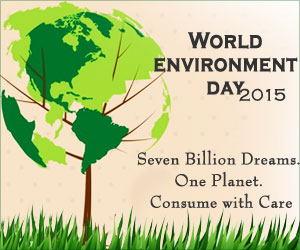Environment is the surroundings in which we dwell. The environment in which we live has an impact on our health and well being. According to World Health Organisation, “environmental health includes all the physical, chemical, and biological factors external to a person, and all the related factors that impact our behavior. It encompasses the assessment and control of those environmental factors that can potentially affect health.”
Each year September 26 is observed as World Environmental Health Day to create and spread awareness towards a better, healthier tomorrow. Environmental health focuses on creating health supportive environments, which are disease free and more sustainable. It aims at making the world a better place to live by conserving its natural state.The theme for 2015 World Environmental Health Day is ‘Children are our future! Lets protect their environment and health’. Today, the environment is contaminated with dangerous pollutants that pose physical, chemical or biological hazards to public health. This is a prime concern and the public at large must protect the future generation from the harmful effects of these hazards.
Environmental hazards that affect children and risk factors
The factors responsible for causing environmental hazards are broadly grouped into three categories, namely, Physical, Chemical and Biological.Physical hazards: These include consequences that occur during natural calamities like earthquake, floods, volcanic eruptions, landslide etc. and other ongoing phenomenon like UV radiations and radioactive emissions. Such occurrences are often followed by an outbreak of epidemics that largely affect children. Special contingency plans for their rescue and safety are needed. Radiation is one of the leading causes of cancer these days. Radiation can cause leukemia and skin cancer - a major cause of death in children below 15.
Human beings are responsible for rising temperatures on planet Earth. Air pollutants like CFC’s, radioactive emissions and industrial gases deplete the atmospheric layers and pose hazardous risk on living organisms. Industries working on nuclear fuel emit ionizing radiations that are a cause of developmental disorders and genetic mutation in babies.
Chemical hazards: Chemical contaminants can be both natural as well as man-made that are risk factors for environmental hazards. The list of synthetic environmental health hazards is countless. With an extraordinary boom in industrial and technological world, there is an increase in the number of health hazards. Naturally occurring metals like lead and mercury are major pollutants. These heavy metals are very harmful. Exposure to such metals in the form of dust or paint put children at great risk. Lead exposure can cause impaired hearing, lower learning capacity, hyperactivity and reduced mental growth. Mercury is another such harmful chemical that should be avoided when children are around.
Harmful chemical emissions and effluents disposed from industries are prime factors for contamination of water bodies. Disposal of metal oxides and pesticides in water bodies are increasing making water unhealthy, affecting the nervous and immune system in children which result in severe sickness. Chemical poisoning can be fatal to kids. They may have problems breathing or can become unconscious.
Biological hazards: Water borne microbial infections are a major reason for many infectious diseases like malaria, typhoid, jaundice, cholera etc in school going children. These infectious diseases result in disrupted routine of the child impacting education and health. Disposal of waste products directly in water bodies are the main cause of microbial contamination of rivers and lakes. This makes drinking water unfit for consumption resulting in severe infections. Developing countries as India face such infectious outbreaks each year with children being at the highest risk of mortality.
Important child health issues
Today, environmental health and safety has become one of the primary subjects of concern at any world conference or summit. In order to reduce the burden of environmental health risks it is imperative to know what the major issues are concerning children and their environmental health. These are:- Air pollutants and smoke resulting in asthma, bronchitis, pulmonary infection and other lung related diseases in children.
- Chemical poisoning due to pollutants like pesticides, arsenic, agri-chemicals, and effluents.
- Heavy metals like mercury and lead cause neurological disorders in children.
- Infectious diseases like malaria, jaundice and other pathogenic diseases affect the immunity and well being of children at large scale.
- Asbestos and electromagnetic radiation fields used in man-made structures and buildings cause cancers and genetic disorders in children.
- Household gases like CO and CO2 produced by chimneys and parents smoking inside homes are harmful for babies and children.
- Pregnant mothers exposed to chemical hazards resulting in perinatal anomalies.
- Children forced to work in industries suffer different occupational risks that have an effect on their health.
- Developing countries to devise coping strategies for aftermaths of various natural disasters like famine, earthquake, floods that leave children impoverished and nutritionally weak.
- Undernourished children due to socio-economically backward societies.
Our responsibilities towards creating a better world for our children
Children are our future and we must ensure a healthy and sound environment to live. Small steps can help create a better world for them:- Your home is the place to start with. Keep the chemicals and pesticides away from children and be cautious while using them.
- Dispose waste according to proposed guidelines. Batteries and biological waste must be disposed carefully.
- Test your drinking water at regular intervals for possible lead and microbial contamination. Keep it in a clean place.
- Support various public health interventions by government such as vaccination programmes and regular health checkups.
- Keep a check on weather conditions if residing in a vulnerable area. Keep the emergency phone numbers handy in case of any natural calamity.
- Do not smoke in the house and clean off the vents and chimneys regularly.
- Prevent children from playing in direct sun.
- Prevent children from working at hazardous industries.
- Ensure proper nutrition to children and seek medical advice whenever required.
- Promote environment friendly activities. Keep the surroundings clean and green.
References:
1. http://www2.epa.gov/children/childrens-environmental-health-facts2. http://www.nrdc.org/health/kids/g5worst.asp
3. https://www.aap.org/en-us/advocacy-and-policy/federal-advocacy/Pages/EnvironmentalHealth.aspx
4. http://www.ifeh.org/wehd/
Source-Medindia










